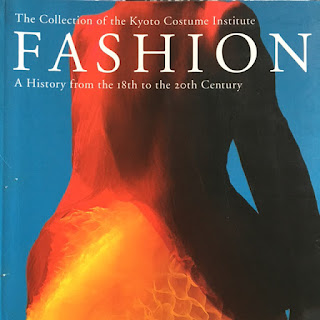During 'normal times' I enjoy going to exhibitions on a regular basis and am really missing my dose of weekly culture. Luckily I have an extensive collection of reference books that I've amassed over the years and I'm getting a small slice of culture from those instead. The latest is this book called 'Fashion' by the Kyoto Fashion Institute. The KCI focuses on Western women's clothing (from the 18th to the 20th Century) yet it also highlights how much of an influence Japanese design and designers have had on those fashions.
In the mid- nineteenth century a wide variety of Japanese items were suddenly available to the Western market and Japanese images inspired Western design. Even the use of lacquerware became popular in the use of bags, cigarette cases and belt buckles like the ones below.
The scallop design symbolises the sea in Japanese art and creates a pleasing geometric design. It is used to stunning effect in this 1920s beaded dress.
One dress that caught my eye was this beautiful bustle dress from the 1870s that uses a white kimono fabric embroidered with wisteria, refashioned into the popular style of the time. Many women started wearing kimonos as dressing gowns.
Dresses made of paper were worn during the Edo period in Japan and were considered extremely stylish. Designer, Kawakubo, created these modern versions of paper dresses inspired by the stencils used for printing. When used in this way, they take on the nature of lace.
John Galliano used transparent fabrics, the micro-mini and a garter belt as inspiration for his modern geisha girl look, using high-quality tailoring techniques.
Japanese obi fabrics are naturally thick and often opulently designed and lend themselves perfectly to tailoring and creating drama, like this Christian Dior cocktail dress created in 1958.
In the 1960s, Gernreich expressed kimonos though knitted outfits. Here, the obi silhouette becomes the focal point of a simple black and white checked dress.
Mariano Fortuny specialised in long, draped silhouettes and the kimono was a great inspiration. This straight-cut light brown velvet coat, designed in the 1910s, is decorated with a stencil print of a traditional Japanese pattern.
Yohji Yamamoto refashioned the rectangular obi belt into a dramatic dress. The bold stylised chrysanthemum design adds drama and contrast to the simple black on the top half of the dress.
The outfit below was created by Masaki Matsushima in 1997. It consists of a black cotton dress with a white scale motif printed on the reverse side. The dress on the right was worn over the top of it.












No comments:
Post a Comment